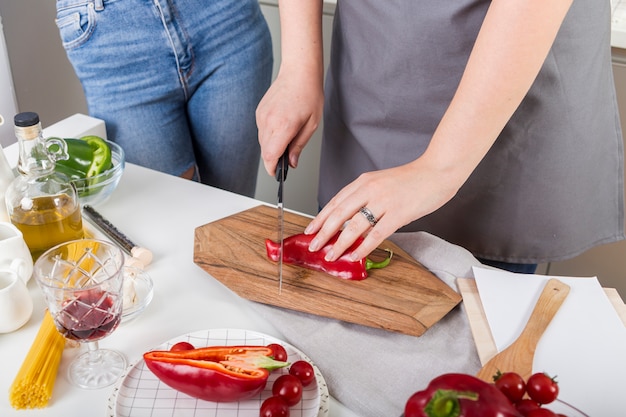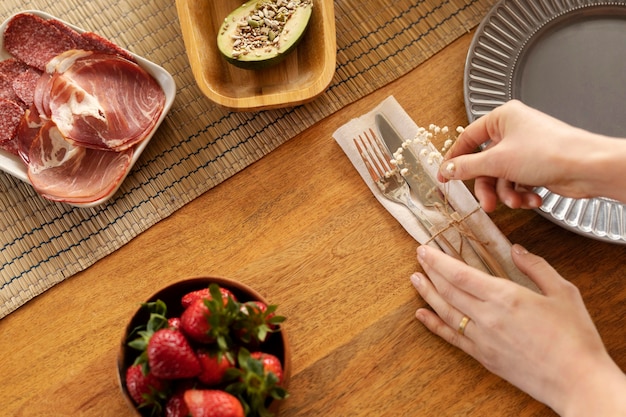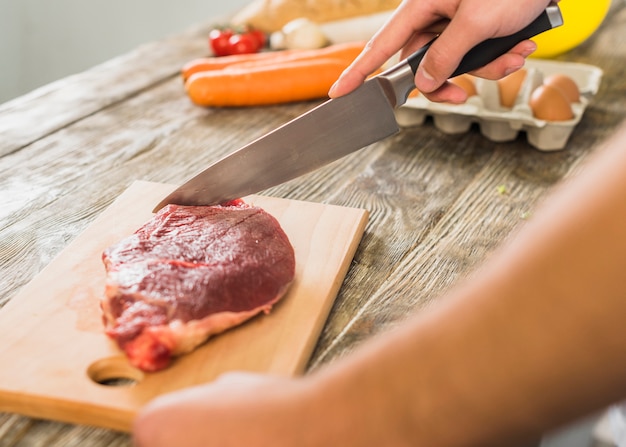Ah, steak. The mere mention of it conjures up images of sizzling heat, mouthwatering aromas, and the satisfying crunch of a perfectly seared crust. I've been a steak enthusiast for as long as I can remember, and over the years, I've learned a few things about turning out a steak that's so good, it'll make you want to dance a jig. So, grab your favourite beverage, put on your apron, and get ready to embark on a journey to steak nirvana!
This isn't just another recipe. It's a deep dive into the world of steak, covering everything from choosing the right cut to mastering the art of the sear, and even exploring some unique cooking methods. We'll uncover the science behind a juicy steak, learn to read the signs of perfect doneness, and discover the finishing touches that elevate your steak to another level. Ready to take your steak game to the next level? Let's get started!
(Part 1) Choosing the Right Cut: The Foundation of a Great Steak

You can't expect to create a culinary masterpiece without starting with quality ingredients. When it comes to steak, that means choosing the right cut. And trust me, there are plenty to choose from, each with its own unique characteristics and best uses.
The Big Three: Ribeye, Striploin, and Fillet
These are the classic cuts, the heavyweights of the steak world. They're known for their flavour, tenderness, and ability to hold their shape well on the grill or in the pan. Let's break them down:
- Ribeye: Ah, the ribeye. This is my personal favourite. It's a true indulgence, brimming with rich flavour and juicy tenderness. The marbling, those beautiful streaks of fat, are what make this cut so irresistible. It's also forgiving for beginners, making it a great choice for those new to steak cooking.
- Striploin: A little leaner than the ribeye, the striploin is no less delicious. It offers a wonderful balance of flavour and tenderness, making it a versatile choice for grilling, pan-frying, or even grilling with a little smoke.
- Fillet: The fillet, also known as tenderloin, is the most tender cut of all. It's like a luxurious cloud of flavour, melting in your mouth with every bite. It's a good choice for those who prefer a leaner steak, but it can be a bit drier than the other cuts, so it's essential to cook it with care to avoid overcooking.
Beyond the Big Three: Exploring the Lesser-Known Cuts
Don't be afraid to venture beyond the classic cuts! Some of the lesser-known options are packed with flavour and offer a different texture, adding a new dimension to your steak experience.
- flank steak: This long, flat cut is a favourite for grilling or marinating. It has a robust, beefy flavour, but it's a bit tougher than the classic cuts. Remember to slice it thinly after cooking to make it easier to chew.
- skirt steak: Similar to flank, but a bit more tender, skirt steak is a great choice for fajitas or grilling. Its strong, almost smoky flavour makes it a real standout.
- Top Sirloin: A good compromise between the classic cuts and the less-known ones, top sirloin is leaner than ribeye but still boasts a rich, flavourful profile.
(Part 2) The Essential Arsenal: Tools of the steak master

Before you dive into the world of steak cooking, you'll need a few essential tools. This isn't about fancy gadgets, but about the tools that make a real difference in the quality of your steak.
The cast iron pan: Your Steak's Ultimate Companion
If you're serious about steak, you need a cast iron pan. These heavy-duty pans heat evenly and retain heat exceptionally well, creating the perfect environment for a beautiful sear. My trusty cast iron pan has been in the family for years and has seen countless steaks come and go, but it's still going strong. If you don't have a cast iron pan, a high-quality stainless steel pan will also do the trick.
The meat thermometer: Your Steak's Guardian Angel
Overcooked steak is a tragedy that none of us want to experience. That's where the trusty meat thermometer comes in. It's the ultimate tool for achieving the perfect level of doneness, every time. Don't be afraid to use it, even if you think you can judge doneness by feel. Trust me, the thermometer is your friend.
The Grill: For that Smoky Kiss of Heaven
If you're lucky enough to have a grill, you have a world of steak possibilities at your fingertips. There's just something about that smoky flavour that elevates a steak to another level. However, make sure you have a grill that can get really hot for a proper sear.
Optional Extras: Steak Weights and a meat mallet
These tools aren't absolutely essential, but they can be helpful for certain situations. Steak weights help ensure even cooking by distributing heat evenly, and a meat mallet can help tenderise tougher cuts. But if you're just starting out, you can certainly get by without them.
(Part 3) Seasoning Your Steak: Enhancing the Natural Flavour

Remember, when it comes to seasoning, less is more. You want to enhance the steak's natural flavour, not bury it under a mountain of spices.
Salt and Pepper: The Timeless Duo
You can't go wrong with salt and pepper. It's a classic combination that delivers a perfectly balanced flavour. I like to season my steak generously with salt and pepper about 30 minutes before cooking. This gives the salt time to draw out moisture, which helps create a crispier, more flavourful crust.
Garlic: Adding a Touch of Zing
A few cloves of garlic, crushed or sliced, can add a delicious touch of flavour to your steak. Add them to the pan with the steak or rub them onto the meat before cooking for a subtle but noticeable garlic aroma.
Herbs: A Burst of Freshness
Fresh herbs, such as rosemary, thyme, or oregano, add a lovely layer of freshness to a steak. Just use them sparingly to avoid overpowering the steak's flavour.
Spice Blends: For the Bold Palate
If you're feeling adventurous, you can try adding a spice blend like a steak seasoning mix or a blend of paprika, chili powder, and cumin. But remember, less is more.
(Part 4) mastering the sear: The Secret to a Beautiful Crust
The sear is what truly transforms a steak from ordinary to extraordinary. It's that crispy, golden-brown crust that traps flavour and moisture within the meat. It's also a testament to your cooking skills.
Heat, Heat, Heat: Get That Pan Scorching Hot!
This is non-negotiable. You want your pan to be screaming hot before you add the steak. The hotter the pan, the more intense the sear, and the crispier the crust.
Don't Crowd the Party: Give Your Steak Some Space
Overcrowding the pan is a recipe for disaster. The steak won't sear properly and will likely steam instead, resulting in a soggy, disappointing mess. Give your steak enough space to breathe and develop that beautiful crust.
The Right Oil: High smoke point for a Crispy Crust
Olive oil is fantastic for low-heat cooking, but for searing, you need an oil with a higher smoke point. I prefer avocado oil or grapeseed oil, as they can handle the intense heat without burning.
Patience is Key: Let It Cook!
Once you've placed the steak in the pan, let it cook undisturbed for 2-3 minutes per side. This gives it time to develop that gorgeous, crispy crust. Flipping too soon will prevent a proper sear.
(Part 5) Navigating the Levels of Doneness: From Rare to Well-Done
Now we're getting into the heart of steak cooking: doneness. Everyone has their own preference, but it's important to understand the different levels of doneness, so you can cook your steak to perfection.
A Quick Guide to Doneness: Temperature and Texture
Here's a quick guide to the different levels of doneness, along with their internal temperatures:
| Doneness | Internal Temperature (°F) | Internal Temperature (°C) | Texture |
|---|---|---|---|
| Rare | 125-130 | 52-54 | Cool, very red centre |
| Medium-Rare | 130-135 | 54-57 | Warm, red centre with a slight pink ring |
| Medium | 135-140 | 57-60 | Warm, pink centre with a hint of brown |
| Medium-Well | 140-145 | 60-63 | Hot, mostly brown with a hint of pink |
| Well-Done | 145 | 63 | Hot, completely brown and firm |
Understanding Internal Temperature: The Truth About Doneness
The most accurate way to determine doneness is to check the internal temperature of the steak. Use a meat thermometer to check the temperature in the thickest part of the steak, making sure not to touch the bone.
Don't Fear the Pink: Embracing Rare and Medium-Rare
Many people are afraid of pink meat, but there's no reason to be. Pink is a sign of a perfectly cooked steak! The pink colour comes from myoglobin, a protein that gives meat its colour. When meat is cooked, the myoglobin changes colour, but this doesn't affect the taste or safety. If you're new to rare or medium-rare steak, start with medium-rare and see how you like it. You might be surprised at how juicy and flavourful it is!
(Part 6) Finishing Touches: Taking Your Steak to the Next Level
You've got a beautifully seared steak cooked to your desired doneness. Now it's time to add a few finishing touches that will take your steak from good to extraordinary.
Resting: The Secret to Juicy, flavorful steak
Resist the temptation to dive in right away! Let your steak rest for 5-10 minutes before slicing. This allows the juices to redistribute throughout the meat, resulting in a more tender, juicier, and flavourful steak.
Adding a Sauce: A Symphony of Flavour
A good sauce can elevate your steak to new heights. Here are a few classic sauce ideas that pair beautifully with steak:
- Béarnaise Sauce: This classic French sauce, with its rich, buttery flavour and tangy notes, is a perfect match for a juicy ribeye.
- Peppercorn Sauce: Add a spicy kick to your steak with a peppercorn sauce. Try it with a sirloin for a delicious contrast.
- Red Wine Sauce: Rich and full-bodied, a red wine sauce adds a complex depth of flavour to a fillet or a striploin.
- Mushroom Sauce: Earthy and decadent, a mushroom sauce is a delicious accompaniment to almost any cut of steak.
Serving: The Grand Finale
Now it's time to serve your masterpiece! I like to pair my steak with a side of roasted vegetables, mashed potatoes, or a simple green salad. However, the possibilities are endless. The most important thing is to serve your steak while it's hot and enjoy the fruits of your labour.
(Part 7) Expanding Your Horizons: Beyond the Pan
While pan-frying is a classic technique, there are plenty of other ways to cook a delicious steak. Let's explore some of the exciting possibilities beyond the traditional method.
Grilling: For that Smoky Kiss of Heaven
Grilling is a fantastic way to add that unmistakable smoky flavour to your steak. Just make sure your grill is nice and hot, and don't overcrowd the grill grate. You want those beautiful sear marks and the smoky flavour to permeate the meat.
reverse searing: For Evenly Cooked Perfection
Reverse searing is a technique where you cook the steak at a low temperature until it reaches your desired doneness, then sear it quickly over high heat to achieve that gorgeous crust. This method ensures even cooking, resulting in a steak that is both tender and juicy.
Sous Vide: The Precision Cooking Technique
Sous vide is a method that involves cooking food in a water bath, allowing you to achieve perfect temperature control. This technique ensures that your steak is cooked to the exact desired doneness, every time. Just remember to sear it afterwards to achieve that crispy crust.
Air Fryer: Quick and Easy Steak Cooking
The air fryer is a modern-day marvel that allows for quick and easy steak cooking. It produces a crispy crust and evenly cooked inside. Just be careful not to overcook it!
(Part 8) FAQs: Your Steak Questions Answered
1. How do I know if my steak is safe to eat?
Steak is safe to eat when it reaches an internal temperature of 145°F (63°C). This ensures that any harmful bacteria are eliminated. You can use a meat thermometer to check the temperature.
2. What's the best way to store steak?
Store steak in the refrigerator on a plate, covered with plastic wrap, for up to 3-5 days. You can also freeze steak for up to 3-6 months. Just make sure to wrap it tightly in plastic wrap and then in foil to prevent freezer burn.
3. What should I do if my steak is overcooked?
Don't despair! Even overcooked steak can be salvaged. You can try slicing it thinly and using it in a stir-fry or pasta dish. You can also make it into steak tacos or fajitas.
4. What's the difference between marbling and fat?
Marbling refers to the streaks of fat within the meat. It's important because it contributes to flavour and tenderness. Fat, on the other hand, is the layer of fat that surrounds the meat. This fat can be rendered down and used for cooking, but it's not as important for flavour and tenderness as marbling.
5. What's the best way to clean a cast iron pan?
The best way to clean a cast iron pan is to scrub it with hot water and a stiff brush. Avoid using soap, as it can strip the pan of its natural seasoning. If the pan is really dirty, you can sprinkle it with coarse salt and scrub it with a damp paper towel. Just make sure to dry it thoroughly after cleaning.
And there you have it! My ultimate guide to cooking a perfectly juicy steak. Now go forth, armed with this knowledge, and unleash your inner steak master. You'll be wowing your friends and family with your delicious creations in no time. Happy grilling, and happy eating!
Everyone is watching

Corn on the Cob: The Ultimate Guide to Perfectly Cooked Ears
Healthy MealsAh, corn on the cob. Just the name evokes images of sunny days, barbecues, and that sweet, juicy flavour that ...

Scallops: The Ultimate Guide to Perfect Cooking
Healthy MealsAh, scallops. Those delicate, sweet, and utterly delicious morsels of the sea. They hold a special place in my...

Spaghetti Squash: The Ultimate Guide to Cooking and Serving
Healthy MealsRemember that time you saw spaghetti squash at the supermarket, looking all bumpy and strange, and thought, "W...

Salmon Cooking Times: Perfect Guide for Every Recipe
Healthy MealsLet me tell you, cooking salmon is an art form. It's all about getting that perfect balance: juicy and tender,...

Ham Cooking Time: How Long to Bake, Smoke, or Boil a Delicious Ham
Healthy MealsAh, ham. It's a classic, isn't it? A real crowd-pleaser, especially around holidays. And when done right, it'...
